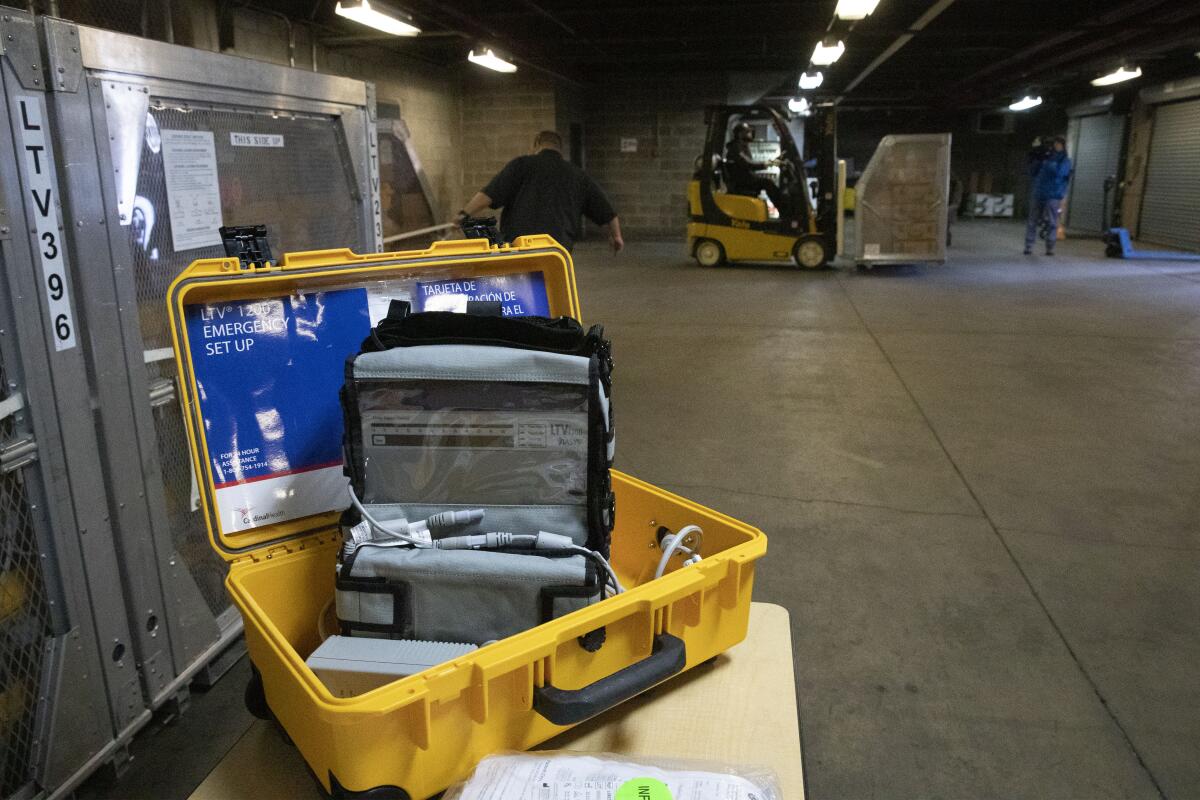California once had mobile hospitals and a ventilator stockpile. But it dismantled them

- Share via
They were ready to roll whenever disaster struck California: three 200-bed mobile hospitals that could be deployed to the scene of a crisis on flatbed trucks and provide advanced medical care to the injured and sick within 72 hours.
Each hospital would be the size of a football field, with a surgery ward, intensive care unit and X-ray equipment. Medical response teams would also have access to a massive stockpile of emergency supplies: 50 million N95 respirators, 2,400 portable ventilators and kits to set up 21,000 additional patient beds wherever they were needed.
In 2006, citing the threat of avian flu, then-Gov. Arnold Schwarzenegger announced the state would invest hundreds of millions of dollars in a powerful set of medical weapons to deploy in the case of large-scale emergencies and natural disasters such as earthquakes, fires and pandemics.
“In light of the pandemic flu risk, it is absolutely a critical investment,” he told a news conference. “I’m not willing to gamble with the people’s safety.”
The state, flush with tax revenue, soon sank more than $200 million into the mobile hospital program and a related Health Surge Capacity Initiative to stockpile medicines and medical gear for use in outbreaks of infectious disease, according to former emergency management officials and state budget records.
But the ambitious effort, which would have been vital as the state confronts the new coronavirus today, hit a wall: a brutal recession, a free fall in state revenues — and in 2011, the administration of a fiscally minded Democratic governor, Jerry Brown, who came into office facing a $26-billion deficit.
And so, that year, the state cut off the money to store and maintain the stockpile of supplies and the mobile hospitals. The hospitals were defunded before they’d ever been used.
Much of the medical equipment — including the ventilators, critical life-saving tools that are in short supply in the current pandemic — was given to local hospitals and health agencies, former health officials said. But the equipment was donated without any funding to maintain them. The respirators were allowed to expire without being replaced.
Together, these two programs would have positioned California to more rapidly respond as its COVID-19 cases exploded. The annual savings for eliminating both programs? No more than $5.8 million per year, according to state budget records, a tiny fraction of the 2011 budget, which totaled $129 billion.
“When you’re stretched, prevention and readiness, future needs — unfortunately, that’s what gets cut,” said state Sen. Richard Pan of Sacramento, chairman of the Senate Health Committee, who fought the cuts as a first-term assemblyman.
Now, many California hospitals are being forced to ration their inadequate supply of N95 masks, and hospitals are rushing to rent ventilators in anticipation of a severe shortage as COVID-19 caseloads grow. A nursing union, National Nurses United, organized a protest earlier this month over inadequate safety equipment; in a survey, only 55% of their members said they had access to N95 masks.
Preparing for a pandemic
Dr. Howard Backer spent years preparing the state for a flu pandemic and then watched it all fall apart.
Backer had worked as an emergency room physician for 25 years before becoming the state’s chief medical consultant on disaster preparedness efforts, and later associate secretary for emergency preparedness, under Schwarzenegger.
“We began doing various kinds of disaster planning around infectious agents,” he recalled. First smallpox; then anthrax; then H5N1, or bird flu; and, more broadly, “pandemic influenza.”
As part of that effort, starting in 2006, he helped develop and implement the state’s drive to stockpile emergency medical resources.
After Schwarzenegger left office, Backer was appointed by Brown to head the Emergency Medical Services Authority, the state agency overseeing the mobile hospitals, just as they were defunded.
“It’s the nearsightedness of political decision-making,” said Backer, who retired last year. “If you talked to the experts, we knew that pandemics were going to come around.”
Now, it’s here, with California under sweeping stay-at-home orders as one of the global hotspots of the COVID-19 pandemic.
“These supplies were exactly for this scenario,” he said.
Through a spokesperson, Brown, the former governor, declined to be interviewed for this story. Officials in the state Department of Finance declined to comment. Officials with the state Public Health Department declined interviews and provided only brief written answers to some questions, declining to provide a full accounting of the stockpile.
Jennifer Lim, acting chief deputy director for the Emergency Medical Services Authority, said by email that after the mobile hospital program was defunded, the state had “redesigned” it, converting the units into what she called “mobile medical shelters.” One was given to the California National Guard, and another was broken up into parts and distributed to local agencies. Only one shelter was kept by the state.
“The purpose of the redesign is to modify and expand the potential uses of the equipment into general staging, stabilization, and shelter capacity,” she said.
The conversion was effectively a downgrade. Lim acknowledged that the shelters lack “biomedical equipment and medical supplies.” They are essentially high-end tents, Backer said, a far cry from mobile hospitals that he said could have been treating at least 600 COVID-19 cases at a time today.
In addition to the hospitals, the state had stockpiled enough supplies to set up 21,000 beds to provide medical care to patients in alternative care sites such as community centers and gymnasiums.
With the funding cut, the state gave away some of the supplies and even considered disposing of what couldn’t be given away, Backer said. In the end, Backer said he’s not sure what happened to it all, and the California Department of Public Health did not answer questions about what became of the alternative care site supplies.
A little over a week ago, Gov. Gavin Newsom warned that in a worst-case scenario, 25 million Californians could be infected with the new coronavirus by mid-May. He said the state is scrambling to increase its inventory of 90,000 hospital beds by 50,000.
Newsom asked the U.S. Navy to bring the 1,000-bed hospital ship Mercy to Los Angeles for help during the crisis. It arrived on Friday.
In televised remarks Monday, Newsom said the state will lease beds in struggling hospitals around the state and is eyeing convention centers, motels and state university dormitories for use as hospital wards. One such lease, in Daly City, may cost the state as much as $3.2 million a month for 177 beds.
“That’s what those alternative care site beds were for,” Backer said.
At its height, the state’s stockpile held more than 50 million N95 respirators, but without continued funding, that supply dwindled. Some were used during California’s wildfires and not replaced, and others went past their expiration date. As the coronavirus arrived in California, that supply was down to 21 million.
Now there is an urgent demand for respirators to protect healthcare workers from becoming infected by their patients. Earlier this month, California’s Public Health Department announced that it would be releasing millions of respirator masks from the stockpile, but warned that some are past their expiration date and thus “are approved for use only in limited, low-risk circumstances,” not for treating patients with COVID-19.
In response to questions, the department said all 21 million are past their expiration date.
The department said it now had 900 ventilators “on hand,” but didn’t clarify what that means. That’s 1,500 fewer than the original stockpile.
California is now trying to procure more. In his Monday remarks, Newsom said Tesla auto magnate Elon Musk had obtained 1,000 ventilators and delivered them for use in Los Angeles. And the governor said the state was now seeking to purchase another 500 million N95 respirators on the open market.
“We don’t rush to do everything overnight to have assets sitting there for the surge,” Newsom said. “This is done in a very sequential way and a very methodical way and a very deliberative way.”
Surge capacity
Schwarzenegger was in his second year as California governor when Hurricane Katrina hit New Orleans in 2005. The tremendous suffering caused by the disaster troubled him, recalled Dr. Cesar Aristeiguieta, who was Schwarzenegger’s emergency medical director from 2005 to 2007 and is now an emergency physician in Houston.
The governor “was very concerned by the images he was seeing on TV,” he said. “He wanted to do something to prepare the state for future calamities.” One strategy Schwarzenegger greenlit was the mobile hospitals.
“They were not like a ‘M*A*S*H’ tent on TV,” said Aristeiguieta, who supervised the startup of the program. “They were fully insulated, HVAC-equipped, semi-permanent tents. They had ventilators, a full complement of medications, and they would roll out in 18-wheelers with [a Highway Patrol] escort. They had sleeping quarters for the staff — really comprehensive.”
Other features included an emergency room, an intensive care unit, an operating room and surgical wards, according to state records.
The mobile hospital program was created with earthquakes in mind — the 1994 Northridge earthquake in the San Fernando Valley had killed at least 57 and injured about 9,000. The governor’s Health Surge Capacity Initiative, including the stockpiles of respirators and ventilators, was geared toward a flu pandemic. The state Legislature allocated $214 million in startup costs, state records show.
The mobile hospitals took up a lot of warehouse space and had to be kept in deployable condition. As for the health department’s 2,400 portable battery-powered ventilators, ongoing maintenance was critical, according to Lori Johnson, who worked for Cardinal Health, which sold the machines to the state. She recalled that staff had to routinely service and clean machines and recharge batteries to ensure the ventilators would be ready in an emergency.
Other gear had to be regularly maintained, and some supplies had to be replaced as they reached their expiration dates. Maintenance and storage costs for the programs were about $5.8 million a year, according to state records — $1.7 million for the hospitals and $4.1 million for the medical stockpile.
Then the 2008 recession clobbered the state budget, and some lawmakers joined Brown’s finance officials in questioning spending on emergency preparedness.
The funding to maintain the hospitals and the stockpile of medical supplies was zeroed out in 2011. In a budget message that year, Brown said the programs had been set up to counter “a potential influenza pandemic which did not occur.”
The Emergency Medical Services Authority was given a year to try to find another funding source to keep the hospitals going. Backer scrambled to save them by reaching out to the private sector but was unable to raise the money.
“We really tried hard to convince people that this is a worthwhile investment,” Backer said. “It was quite disappointing.”
Then-Assemblyman Bill Monning, a Democrat from Carmel, suggested the state should sell its unneeded medical equipment on eBay. “I say this not intending to be funny,” the Sacramento Bee quoted him as saying. Monning, now a state senator, did not respond to an interview request.
Eventually, the ventilators and much of the other medical equipment were given away — donated to county health departments and local hospitals, said Daniel Smiley, who was then chief deputy director in the emergency medical office.
Ventilators dispersed
What exactly happened to the 2,400 ventilators isn’t clear. Several dealers who buy and sell used medical equipment said they recall many of California’s ventilators ended up being resold by hospitals and nursing homes to other dealers, who then likely shipped them out of the United States.
Dr. Lewis Rubinson, chief medical officer at Morristown Medical Center in New Jersey and an authority on the availability of medical ventilators, said California was not alone. Rubinson, who led a 2010 study quantifying how many ventilators were available at hospitals throughout the country, said several other states also decided to save on the costs of maintaining and storing their stockpiled ventilators by instead donating the machines to hospitals, nursing homes and other facilities.
Had the state kept its ventilators and maintained them, most would still be in good working order today, according to several experts from the ventilator and healthcare industries. A stockpile of 2,400 well-maintained ventilators would be a valuable asset for any state in its fight to treat patients with COVID-19, Rubinson said.
“I would say that a number of them are really kicking themselves,” Rubinson said.
California’s economy rebounded, and soon the state had a budget surplus. But Brown’s administration didn’t restore the emergency programs. At a 2015 hearing, state Sen. Hannah-Beth Jackson, a Santa Barbara Democrat, pressed emergency officials on why they weren’t seeking money to rebuild the mobile hospital program.
“You know, we never know when the next disaster is going to occur,” she said. “But if these things have been mothballed, there are going to be a lot of questions asked.”
More to Read
Sign up for Essential California
The most important California stories and recommendations in your inbox every morning.
You may occasionally receive promotional content from the Los Angeles Times.










